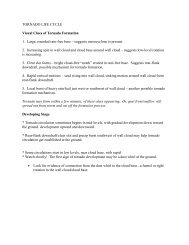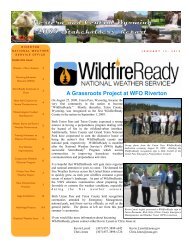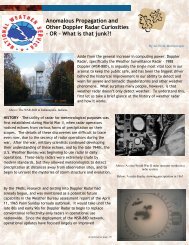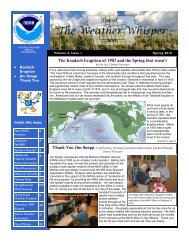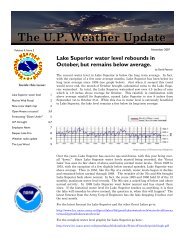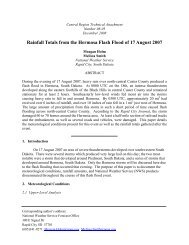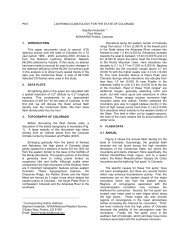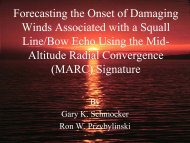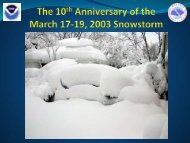Forecasting Damaging Winds from a Squall Line Using the MARC ...
Forecasting Damaging Winds from a Squall Line Using the MARC ...
Forecasting Damaging Winds from a Squall Line Using the MARC ...
Create successful ePaper yourself
Turn your PDF publications into a flip-book with our unique Google optimized e-Paper software.
<strong>Forecasting</strong> <strong>the</strong> Onset of <strong>Damaging</strong><br />
<strong>Winds</strong> Associated with a <strong>Squall</strong> <strong>Line</strong>/<br />
Bow Echo <strong>Using</strong> <strong>the</strong> Mid-Altitude<br />
Radial Convergence (<strong>MARC</strong>) Signature<br />
By<br />
Gary K. Schmocker and Ron W. Przybylinski<br />
National Wea<strong>the</strong>r Service, St. Louis, MO<br />
Updated/enhanced by Ted Funk<br />
National Wea<strong>the</strong>r Service, Louisville, KY<br />
Radar Based Signatures of <strong>Damaging</strong> <strong>Winds</strong><br />
Reflectivity characteristics of a<br />
“distinctive” bow echo<br />
(Fujita, Przybylinski & Gery):<br />
• Outward bowing of line echo<br />
• Weak echo channels<br />
WECs)/ rear inflow notches<br />
(RINs) identifying location of<br />
rear inflow jet (RIJ)<br />
• Strong low-level reflectivity<br />
gradient on leading edge<br />
• Max echo top aloft usually<br />
displaced slightly downwind<br />
<strong>from</strong> low-level reflectivity<br />
for organized bows
Two Examples of Bow Echoes with Strong Low-Level<br />
Reflectivity Gradients and Pronounced WECs/RINs<br />
A tight reflectivity gradient implies a strong updraft/downdraft interface and greater<br />
threat for continued active and potentially damaging squall line. Arrows denote<br />
locations of weak echo channels (WECs)/rear inflow notches (RINs) in <strong>the</strong> back side of<br />
<strong>the</strong> line. These are indicative of enhanced pulses in <strong>the</strong> rear inflow jet and likely<br />
locations for enhanced wind damage along <strong>the</strong> leading edge gust front.<br />
Doppler Radar Based Signatures of <strong>Damaging</strong> <strong>Winds</strong><br />
•High VIL values (intense storm/updraft capable of producing wind damage,<br />
but better correlated to heavy rain and/or hail)<br />
• Base velocity of 50 kts or more at lowest elevation (limited range)<br />
• Weak echo channels (WECs)/rear inflow notches (RINs) in reflectivity data<br />
suggest evaporative cooling and locations of <strong>the</strong> rear inflow jet (RIJ) and wind<br />
damage along <strong>the</strong> leading edge of <strong>the</strong> convective line<br />
• Identification of vortices –<br />
strong circulations along a line<br />
can enhance low–mid level winds<br />
(RIJ); greatest wind damage<br />
often is observed along bow<br />
apex just south of <strong>the</strong> path<br />
of a cyclonic circulation<br />
(convective line typically<br />
accelerates and/or<br />
“bows out” south of a<br />
strong cyclonic circulation)
<strong>Damaging</strong> Wind Precursors Identified <strong>from</strong> Microburst<br />
Studies on Pulse Type Storms (Eilts et al. -DDPDA)<br />
• Initial reflectivity core development<br />
at a higher height than surrounding<br />
storms (indicative of intense updraft)<br />
• Strong mid-altitude radial<br />
convergence (<strong>MARC</strong> >22 m/s or 50<br />
kts) associated with isolated pulse<br />
type storms (also correlated to<br />
subsequent wind damage in squall lines<br />
and bow echoes<br />
• Rapidly descending reflectivity core<br />
Convergent Signatures in Organized Convection -<br />
Supercells<br />
• Deep Convergence Zone (DCZ) was identified in supercells by Lemon et al. at<br />
<strong>the</strong> interface of <strong>the</strong> updraft/downdraft currents<br />
- this narrow zone represents a region of intense convergence and shear<br />
with an average depth of 10 km<br />
- damaging winds often occur along or just behind <strong>the</strong> DCZ with<br />
mesocyclones and/or gust front tornadoes along it
A Review of <strong>Squall</strong> <strong>Line</strong> Mesoscale Airflow Structures<br />
Development of RIJ attributed to mid-level, mesoscale areas of low pressure<br />
(L3 & L4; Smull & Houze,1987)<br />
L3: Hydrostatically-induced negative pressure perturbations under upshear<br />
tilted warm convective updrafts (and above evaporatively-cooled downdrafts)<br />
L4: Mid-level mesoscale low in <strong>the</strong> stratiform region<br />
Dual Doppler Analysis of a Nor<strong>the</strong>rn Plains <strong>Squall</strong> <strong>Line</strong><br />
(Klimowski 1994)<br />
Observations of <strong>the</strong> mesoscale rear inflow jet (RIJ):<br />
-Rear inflow was initiated near <strong>the</strong> high reflectivity cores of <strong>the</strong> squall line and<br />
was mainly elevated, increasing in magnitude and expanding rearward with time<br />
(RIJ average height was near 4 km MSL)<br />
-Maximum values of <strong>the</strong> rear inflow initially were located near <strong>the</strong> high<br />
reflectivity cores at <strong>the</strong> front of <strong>the</strong> system<br />
-Rear inflow was not homogeneous along <strong>the</strong> length of <strong>the</strong> squall line (variability<br />
in elevation and several local maxima along line existed)<br />
-Rear inflow was stronger where trailing stratiform precipitation region<br />
formed and matured<br />
-Slight positive correlation between <strong>the</strong> development of <strong>the</strong> rear inflow and<br />
<strong>the</strong> development of front-to-rear (FTR) flow (where RIJ was strongest, FTR<br />
usually was maximized)
Reflectivity/Velocity Cross-Sections Perpendicular to <strong>Squall</strong> <strong>Line</strong><br />
Reflectivity contours are solid. Shaded region represents <strong>the</strong> evolution<br />
of <strong>the</strong> mesoscale rear inflow jet (Klimowski 1994). RIJ deflects down to surface<br />
near updraft/downdraft interface along leading line.<br />
Convergent Signatures in Organized Convection –<br />
<strong>Squall</strong> <strong>Line</strong>s/Bow Echoes<br />
• Przybylinski et al. 1995 noted strong mid-altitude radial convergence (<strong>MARC</strong>)<br />
along forward flank of convective lines before <strong>the</strong>y began to “bow out”<br />
• Observations using WSR-88D to survey a component of squall line’s sloping<br />
updraft/downdraft currents along forward flank of MCS during intensifying stage:<br />
For a storm approaching <strong>from</strong> west or upstream of radar:<br />
- region of strong outbound velocities signifies a component of <strong>the</strong> storm’s<br />
updraft current and front-to-rear flow<br />
- region of strong inbound velocities depicts <strong>the</strong> storm’s convective scale<br />
downdrafts and origins of <strong>the</strong> mesoscale RIJ<br />
For a storm departing to east or downstream of radar:<br />
- region of strong inbound velocities signifies a component of <strong>the</strong> storm’s<br />
updraft current and front-to-rear flow<br />
- region of strong outbound velocities depicts <strong>the</strong> storm’s convective scale<br />
downdrafts & origins of <strong>the</strong> mesoscale RIJ<br />
For a storm moving nearly perpendicular to <strong>the</strong> radar: <strong>MARC</strong> may be difficult to<br />
discern (due to <strong>the</strong> viewing angle), but may still be present (so BEWARE)
<strong>MARC</strong> in a Mature MCS<br />
<strong>MARC</strong> Dynamics<br />
• Persistent areas of strong radial convergence (enhanced<br />
convergent velocity differentials) within <strong>the</strong> larger zone of<br />
convergence along <strong>the</strong> forward flank of <strong>the</strong> convective line<br />
appears to be linked to <strong>the</strong> greatest degree of wind damage<br />
• These persistent areas of strong radial convergence (<strong>the</strong><br />
<strong>MARC</strong> velocity signature) are usually located in or just<br />
downwind of <strong>the</strong> high reflectivity cores along <strong>the</strong> leading edge<br />
of <strong>the</strong> line<br />
• These enhanced areas of convergence usually are less than 15<br />
km in length and less than 7 km in width. A strong velocity<br />
gradient between <strong>the</strong> inbound and outbound maxima (nearly<br />
gate to gate) yields <strong>the</strong> strongest actual convergence
Example of <strong>MARC</strong> in a Developing <strong>Line</strong> Echo<br />
White circles enclose 3 <strong>MARC</strong> velocity signatures - enhanced spots<br />
of convergence within an elongated zone of convergence along <strong>the</strong><br />
forward flank of <strong>the</strong> linear convective system over central MO (west<br />
of St. Louis radar site KLSX)<br />
More <strong>MARC</strong> Dynamics<br />
• Once radial velocity differentials reach 25 m/s (50 kts) or greater (actual<br />
convergence values of 2.5 x 10-2 to 5.6 x 10-3 s-1), <strong>the</strong> potential for severe<br />
straight line winds increases<br />
• Radial Convergent Velocity Difference = |V(inbound)| + |V(outbound)|<br />
• Actual Convergence = (|V(inbound)| + |V(outbound)|) / (Distance between<br />
convergent isodops along radial)<br />
• Convective-scale vortices<br />
(tornadic and non-tornadic)<br />
often form in <strong>the</strong> zone or<br />
interface between <strong>the</strong> two<br />
drafts (mainly on <strong>the</strong> updraft<br />
side) where cyclonic or negative<br />
horizontal vorticity is strong.<br />
A cyclonic circulation sometimes<br />
develops on <strong>the</strong> nor<strong>the</strong>rn end<br />
of a <strong>MARC</strong> signature
Reflectivity Characteristics & <strong>the</strong> <strong>MARC</strong> Signature<br />
The <strong>MARC</strong> velocity signature has been observed more frequently with a nearly<br />
solid linear convective segment (left) than with discrete convective cells along<br />
<strong>the</strong> sou<strong>the</strong>rn flank of an asymmetric MCS (right).<br />
Case Sample & <strong>MARC</strong> Characteristics<br />
16 warm season (May-September) MCS cases studied so far
Differences Between Afternoon/Evening and Nocturnal<br />
(Late Night/Early Morning) Cases<br />
• Afternoon/evening cases typically occur in environments with<br />
greater CAPE but less 0-3 km shear<br />
• In nocturnal cases, <strong>MARC</strong> tends to be weaker, shallower, and<br />
found at a lower height<br />
• The horizontal extent of <strong>the</strong> overall convergent region along<br />
<strong>the</strong> forward flank of <strong>the</strong> convective line also is less in <strong>the</strong><br />
nocturnal cases<br />
• The <strong>MARC</strong> signature has shown greater lead time in <strong>the</strong><br />
afternoon/evening cases<br />
Case Example #1 – July 2, 1992<br />
(high instability & moderate shear)<br />
<strong>MARC</strong> tracks & initial wind damage reports (W)
0.5° Reflectivity/SRM Velocity Images at 2303 UTC<br />
Strong <strong>MARC</strong> signatures (within black circles) were evident on <strong>the</strong><br />
leading edge of <strong>the</strong> developing line echo<br />
2321 UTC Reflectivity (0.5°) and SRM Velocity Image (1.5°)<br />
A<br />
Bow echo has developed with 2 <strong>MARC</strong> signatures (within black<br />
circles) south of strong cyclonic vortex (near “A”)
Time-Height Section of Sou<strong>the</strong>rn <strong>MARC</strong> (m/s) Signature<br />
(VIL is plotted on top; W denotes times of wind damage reports)<br />
0.5° Reflectivity/Base Velocity Images at 0007 UTC<br />
Reflectivity shows that within an hour (2303 to 0007 UTC), <strong>the</strong> MCS evolved into a<br />
large, mature bow echo with a large area of greater than 64 kt inbound winds (RIJ;<br />
dark blue in velocity image) at 5-6 kft height northwest of <strong>the</strong> St. Louis radar site<br />
KLSX). Thus, <strong>the</strong> <strong>MARC</strong> signature provided advanced clues that a bowing segment and<br />
enhanced surface wind damage would develop.
Case Example #2 - August 24, 2000<br />
(high instability & weak shear)<br />
<strong>MARC</strong> tracks and wind damage reports (W)<br />
0213 UTC 0.5°<br />
Reflectivity and SRM<br />
Velocity Images<br />
0.5° images over central<br />
MO showed an MCS with 2<br />
<strong>MARC</strong> signatures (near<br />
locations A and B) in <strong>the</strong><br />
developing line segment;<br />
<strong>the</strong>se <strong>MARC</strong> signatures<br />
denote <strong>the</strong> updraft/<br />
downdraft interface in <strong>the</strong><br />
MCS (MCS is located to<br />
northwest of radar site).<br />
B<br />
A
0233 UTC 0.5°<br />
reflectivity and SRM<br />
velocity images<br />
0.5 ° images 20 minutes later<br />
over central MO displayed<br />
streng<strong>the</strong>ning <strong>MARC</strong> signatures<br />
(between dark blue inbounds<br />
and orange and red outbound<br />
colors) as <strong>the</strong> RIJ (dark blue)<br />
intensified; a weak echo<br />
channel was developing on <strong>the</strong><br />
back side of <strong>the</strong> MCS in<br />
reflectivity data.<br />
0238 UTC 0.5° Reflectivity<br />
and SRM Velocity Images<br />
0.5 ° images one volume scan later<br />
showed several important<br />
signatures: 1) strong <strong>MARC</strong> along<br />
<strong>the</strong> leading edge of <strong>the</strong> developing<br />
bow echo; 2) a well-defined RIJ<br />
(dark blue) coincident with a welldefined<br />
weak echo channel in<br />
reflectivity data; 3) since <strong>the</strong> MCS<br />
was moving toward <strong>the</strong> radar, actual<br />
RIJ strength (winds) were greater<br />
than shown in <strong>the</strong> SRM image since<br />
system speed was subtracted out<br />
<strong>from</strong> displayed values (use base<br />
velocity to determine actual speed);<br />
4) broad cyclonic and anticyclonic<br />
vortices (“bookend” or “line end”<br />
vortices) were present on ei<strong>the</strong>r<br />
side of <strong>the</strong> RIJ, which can<br />
accentuate <strong>the</strong> RIJ.
0243 UTC 0.5° Reflectivity<br />
and SRM Velocity Images<br />
A<br />
B<br />
0.5° images showed a weak echo<br />
channel (WEC) in reflectivity data<br />
coincident with strong inbound winds<br />
(i.e., <strong>the</strong> RIJ; dark blue) in SRM<br />
data. Impressive <strong>MARC</strong> still was<br />
present along <strong>the</strong> updraft/<br />
downdraft interface (location A),<br />
indicative that damaging downburst<br />
winds likely would continue at <strong>the</strong><br />
surface. <strong>MARC</strong> also was present at<br />
location B along <strong>the</strong> leading edge of<br />
ano<strong>the</strong>r active portion of <strong>the</strong> MCS,<br />
although displayed <strong>MARC</strong> values were<br />
weaker. However, beware that a less<br />
effective viewing angle may preclude<br />
accurate measurement of actual<br />
<strong>MARC</strong> values and subsequent<br />
downburst potential.<br />
August 24, 2000 <strong>MARC</strong> Vertical Cross-Section Trace
0341 UTC 1.5° Reflectivity<br />
and SRM Velocity Images<br />
C<br />
1.5° images at 0341 UTC showed that<br />
a new <strong>MARC</strong> signature (location C)<br />
rapidly developed just ahead of a 60-<br />
65 dBZ core in <strong>the</strong> large convective<br />
cluster; although <strong>the</strong> cluster showed<br />
little evidence of bowing at this time,<br />
<strong>the</strong> strong <strong>MARC</strong> signature aloft<br />
provided a critical clue and heads-up<br />
that subsequent bowing and surface<br />
wind damage might occur. Thus,<br />
proper identification and evolution of<br />
<strong>MARC</strong> is crucial to provide valuable<br />
lead time in issuing or extending<br />
severe wea<strong>the</strong>r warnings for wind<br />
damage; subsequent downbursts <strong>the</strong>n<br />
can even lead to low-level cyclonic<br />
circulation spin-up and tornado<br />
development.<br />
August 24, 2000 <strong>MARC</strong> Vertical Cross-Section Trace:<br />
Location C<br />
Note that significant <strong>MARC</strong> values <strong>from</strong> about 3-6 km altitude preceded<br />
<strong>the</strong> first report of damaging surface winds by several minutes
0411 UTC 0.5°<br />
Reflectivity and Base<br />
Velocity Images<br />
By 0411 UTC, 0.5° degree<br />
reflectivity and base velocity<br />
images depicted a large, mature<br />
bow echo with an area of strong<br />
inbound winds ( >64 kts…radar<br />
indicated a 93 kt maximum<br />
inbound value) at about 4 kft<br />
altitude northwest of <strong>the</strong> KLSX<br />
radar site. Thus, <strong>the</strong> strong<br />
<strong>MARC</strong> signature at 0341 UTC in<br />
conjunction with developing rear<br />
inflow indeed resulted in<br />
subsequent intense downburst<br />
activity that led to development<br />
of an intense bow echo and<br />
damaging surface winds.<br />
Damage Pictures From a Storm Survey Across Warren<br />
and Montgomery Counties Northwest of St. Louis<br />
Damage to roof (sheet metal) of school in Wright City
Damage Pictures<br />
Below: Tree damage near<br />
a church in Montgomery<br />
County<br />
Above: Tree damage<br />
near Bellflower in<br />
Montgomery County<br />
Damage Pictures<br />
Above: Machine shed blown<br />
down east of Bellflower<br />
Above: Small house<br />
trailer blown over east of<br />
Middletown
Case Example #3 – May 27, 2000<br />
(moderate instability & moderate shear)<br />
<strong>MARC</strong> tracks and wind damage (W)<br />
1.5° Reflectivity/SRM Velocity Images at 0303 UTC:<br />
Note 2 distinct <strong>MARC</strong> signatures (tracks D and E)<br />
E<br />
D
0.5° Reflectivity/SRM Velocity images at 0308 UTC<br />
(Let’s cut a cross-section through <strong>MARC</strong> signature D)<br />
0308 UTC<br />
Reflectivity and SRM<br />
Velocity Vertical<br />
Cross-Section<br />
Reflectivity and SRM velocity<br />
cross-sections at 0308 UTC.<br />
Note <strong>the</strong> significant <strong>MARC</strong> at<br />
<strong>the</strong> top of <strong>the</strong> MCS’s outflow<br />
(gust front) around 7-10 kft<br />
surging ahead of <strong>the</strong><br />
convective towers. Note also<br />
<strong>the</strong> vertical updraft zone<br />
(red outbounds) within <strong>the</strong><br />
active convection and <strong>the</strong><br />
more gentle front-to-rear<br />
system-relative ascent in <strong>the</strong><br />
stratiform area behind <strong>the</strong><br />
leading line and above lowerlevel<br />
rear-to-front flow<br />
(green inbound colors).
1.5° Reflectivity/SRM Velocity Images at 0314 UTC<br />
Blue arrows point to 3 <strong>MARC</strong> signatures (locations D, E, and F)<br />
Let’s cut ano<strong>the</strong>r x-section through D<br />
0314 UTC Reflectivity and<br />
SRM Velocity Vertical<br />
Cross-Sections<br />
Cross-sections at 0314 UTC<br />
depicted <strong>the</strong> top of <strong>the</strong> MCS’s<br />
surging outflow (gust front)<br />
around 7 kft, where rear-tofront<br />
flow was undercutting<br />
and surging ahead of elevated<br />
<strong>MARC</strong> <strong>from</strong> (10-15 kft); also<br />
present were a local outbound<br />
velocity maximum embedded<br />
within front-to-rear flow<br />
around 21 kft, and a welldefined<br />
system-relative frontto-rear<br />
stream behind <strong>the</strong><br />
active convective region<br />
associated with trailing<br />
stratiform precipitation.
Time-height Section of <strong>MARC</strong> Signature “D”<br />
Again, <strong>MARC</strong> was noted well before <strong>the</strong> first report of surface wind damage,<br />
and <strong>MARC</strong> values generally increased leading up to this report<br />
Summary and Key Findings<br />
• The <strong>MARC</strong> velocity signature (i.e., inbound/outbound velocity<br />
differential along <strong>the</strong> same radial) values of greater than or equal to 25<br />
m/s or 50 kt provided average lead times of almost 20 minutes prior to<br />
<strong>the</strong> first report of damaging winds.<br />
• <strong>MARC</strong> often was identified before development of a well-defined bow<br />
echo or strong vortices (mesocyclone or line-end/bookend vortices)<br />
• <strong>MARC</strong> usually was identified at a height between 4-5 km (12-17 kft)<br />
along <strong>the</strong> forward flank of <strong>the</strong> convective line (in or just downwind of<br />
<strong>the</strong> high reflectivity cores within <strong>the</strong> line).<br />
• Since it is a mid-level signature, it can be detected as far as 120 nm<br />
<strong>from</strong> <strong>the</strong> radar using <strong>the</strong> lowest elevation slice.<br />
• The <strong>MARC</strong> velocity signature has been observed more frequently with<br />
a nearly solid linear convective line compared to discrete convective<br />
cells along <strong>the</strong> sou<strong>the</strong>rn flank of an asymmetric MCS (viewing angle may<br />
be a factor).
Summary and Key Findings<br />
• Preliminary results indicate that <strong>the</strong> <strong>MARC</strong> signature is not as<br />
identifiable with nocturnal convection compared to convection<br />
occurring during <strong>the</strong> afternoon/evening hours (weaker magnitudes<br />
and shorter lead times have been observed with <strong>the</strong> nocturnal<br />
cases examined so far, but more cases need to be studied).<br />
• Importance of <strong>the</strong> viewing angle: <strong>MARC</strong> will be underestimated<br />
when <strong>the</strong> convective line is not orthogonal (perpendicular) to <strong>the</strong><br />
radial.<br />
•When evaluating <strong>MARC</strong> and subsequent wind damage potential, you<br />
must understand <strong>the</strong> environment it is occurring in. Even with a<br />
strong <strong>MARC</strong> signature, damaging surface winds are less likely if a<br />
deep (greater than or equal to 2 km), cool, stable boundary layer is<br />
present (i.e., convection is not surface-based but is elevated north<br />
of a stationary/warm front).<br />
References<br />
Campbell, S.D., and M.A. Isaminger, 1990: A prototype microburst prediction product for <strong>the</strong> terminal Doppler<br />
wea<strong>the</strong>r radar. Preprints, 16th Conf. on Severe Local Storms, Kananaskis Park, Canada, Amer. Meteor. Soc.,<br />
393-396.<br />
Eilts, M. D., J. T. Johnson, E. D. Mitchell, R. J. Lynn, P. Spencer, S. Cobb, and T. M. Smith, 1996: <strong>Damaging</strong><br />
downburst prediction and detection algorithm for <strong>the</strong> WSR-88D. Preprints, 18th Conf. On Severe Local<br />
Storms, San Francisco, Amer. Meteor. Soc., 541-545.<br />
Fujita, T. T., 1979: Objectives, operations and results of project NIMROD. Preprints, 11th Conf. on Severe<br />
Local Storms, Boston, Amer. Meteor. Soc., 259-266.<br />
Houze, R. A. Jr., S. A. Rutledge, M.I. Biggerstaff, and B. F. Smull, 1989: Interpretation of Doppler wea<strong>the</strong>r<br />
radar displays of midlatitude mesoscale convective systems. Bull. Amer. Meteor. Soc., 70, 608-618.<br />
Klimowski, B. A., 1994: Initiation and development of Rear Inflow within <strong>the</strong> 28-29 June 1989 North Dakota<br />
mesoconvective system. Mon. Wea. Rev., 122, 765-779.<br />
Lemon, L. R., and S. Parker, 1996: The Lahoma storm deep convergence zone: Its characteristics and role in<br />
storm dynamics and severity. Preprints, 18th Conf. on Severe Local Storms, San Francisco, Amer. Meteor.<br />
Soc., 70-75.<br />
Przybylinski, R. W., and W. J. Gery, 1983: The reliability of <strong>the</strong> bow echo as an important severe wea<strong>the</strong>r<br />
signature. Preprints, 13th Conf. On Severe Local Storms, Tulsa, Amer. Meteor. Soc., 270-273.<br />
_____, Y. J. Lin, G. K. Schmocker, and T. J. Shea, 1995: The use of real-time WSR-88D, profiler, and<br />
conventional data sets in forecasting a nor<strong>the</strong>astward moving derecho over eastern Missouri and central<br />
Illinois. Preprints, 14th Conf. on Wea. Analysis and <strong>Forecasting</strong>, Dallas, Amer. Meteor. Soc., 335-342.
References<br />
_____, G. K. Schmocker, Y. J. Lin, 2000: A study of storm and vortex morphology during <strong>the</strong> ‘intensifying stage’ of<br />
severe wind mesoscale convective systems. Preprints, 20th Conf. On Severe Local Storms, Orlando FL, Amer. Meteor.<br />
Soc., 173-176.<br />
Rasmussen, E. N. and S. A. Rutledge, 1993: Evolution of quasi-two dimensional squall lines. Part I: Kinematics and<br />
reflectivity structure. J. Atmos. Sci., 50, 2584-2606.<br />
Schmocker, G. K., R. W. Przybylinski, and Y. J. Lin, 1996: <strong>Forecasting</strong> <strong>the</strong> initial onset of damaging downburst winds<br />
associated with a Mesoscale Convective System (MCS) using <strong>the</strong> Mid-Altitude Radial Convergence (<strong>MARC</strong>) signature.<br />
Preprints, 15th Conf. On Wea<strong>the</strong>r Analysis and <strong>Forecasting</strong>, Norfolk VA, Amer. Meteor. Soc., 306-311.<br />
_____, R.W. Przybylinski, and E.N. Rasmussen, 2000: The severe bow echo event of 14 June 1998 over <strong>the</strong> mid-<br />
Mississippi valley region: A case of vortex development near <strong>the</strong> intersection of a preexisting boundary and a<br />
convective line. Preprints, 20th Conf. On Severe Local Storms, Orlando FL, Amer. Meteor. Soc., 169-172.<br />
Smull, B. F. and R. A. Houze, Jr., 1987: Rear inflow in squall lines with trailing stratiform precipitation. Mon. Wea. Rev.,<br />
115, 2869-2889.<br />
Weisman, M. L., 1993: The genesis of severe, long lived bow echoes. J. Atmos. Sci., 50, 645-670.<br />
_____, M. L. and R. W. Przybylinski, 1999: Mesoscale convective systems:<strong>Squall</strong> lines and bow echoes, COMET CBL<br />
module, UCAR.<br />
For fur<strong>the</strong>r <strong>MARC</strong> information and o<strong>the</strong>r damaging wind studies,<br />
go to: www.crh.noaa.gov/lsx/science/newcomet.htm




